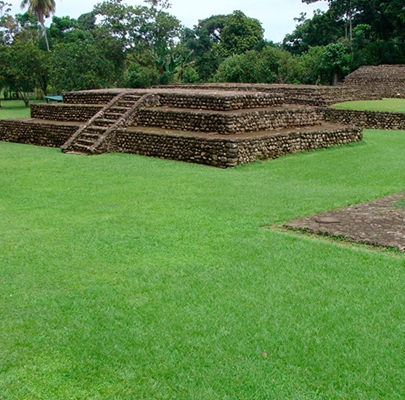
It is possible that the name Izapa is a deformation of the Nahuatl word "Atzacua" (place of the water deposit) or Place of the Salt River. It can also be the word "Ixtapan" (in the sandy soil).
The Mixe-Zoquean culture (related to the Olmec archaeological culture) developed in this place at least in 1500 B.C.; traits of the pre-Maya culture are evident, which are subsequently present throughout the area. The presence of Mexican enclaves for tax collection in the area of the Chiapas coast is evident in all those towns that have names in the Nahuatl language, from Tonalá, Chiapas to El Salvador in Central America.
The various mounds in the area present an arrangement of plazas or patios, which were named according to their shape. At present, Groups A and B (in the core zone of monuments), and Group F towards the north of the complex are the ones that can be visited.
Izapa had a continuous occupation from 1500 BC to 1200 AD. The regularity in the orientations and disposition of the spaces, as well as the constants in the placement of the monuments, indicate a constructive activity under the same basic planning patterns.
Its greatest contribution is the sculpture in bulk in the arrangement of stelae and altars, a cultural element associated with the most important mounds and that appears later in the Maya area during the classic period. Many of these stelae represent characters that appear in the legends of the Popol Vuh, a book that narrates the original ancient traditions of the highland Maya. The "Izapeño style", developed over 700 years (from 600 B.C. to 100 A.D.), was distributed along what is now the coast of Chiapas and the coast of Guatemala.
How to get there
Recommendations: According to the (National Institute of Anthropology and History) INAH to walk the 2.5 kilometers between the main groups of buildings that can be visited (A, B and F), it is necessary to wear comfortable shoes, light clothing, an umbrella (it rains in the afternoons around 2:00 p.m.) and enough drinking water.
Schedule:
Wednesday through Sunday, 9:00 a.m. to 5:00 p.m..
Group F has a different schedule, being closed on Tuesdays.
Cost:
Admission is free. There is a small service module north of the highway (Group F).
Activities:
360 tour
Fair in Honor of Saint Sebastian Martyr
Zinacantán, Chiapas
Candelaria Fair, Cintalapa de Figueroa
Cintalapa, Chiapas
Descent of the Little Virgins of Copoya
Tuxtla Gutiérrez, Chiapas
Comitán de Domínguez, Chiapas

